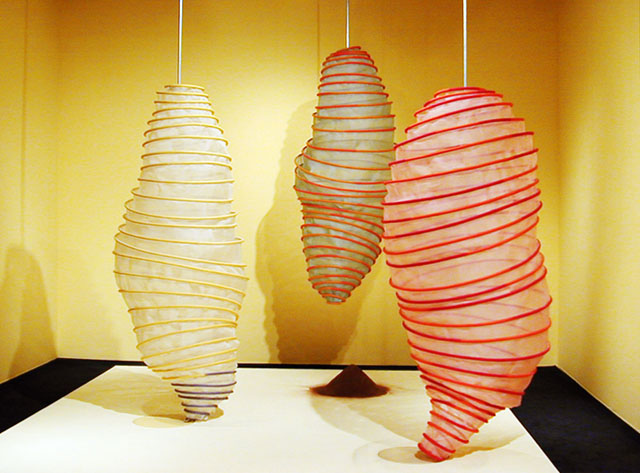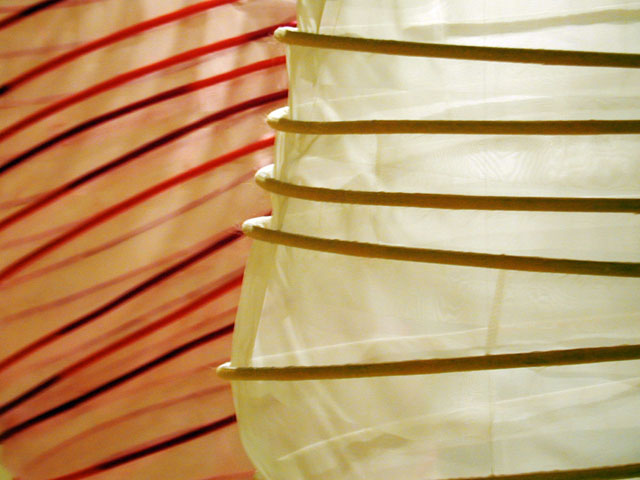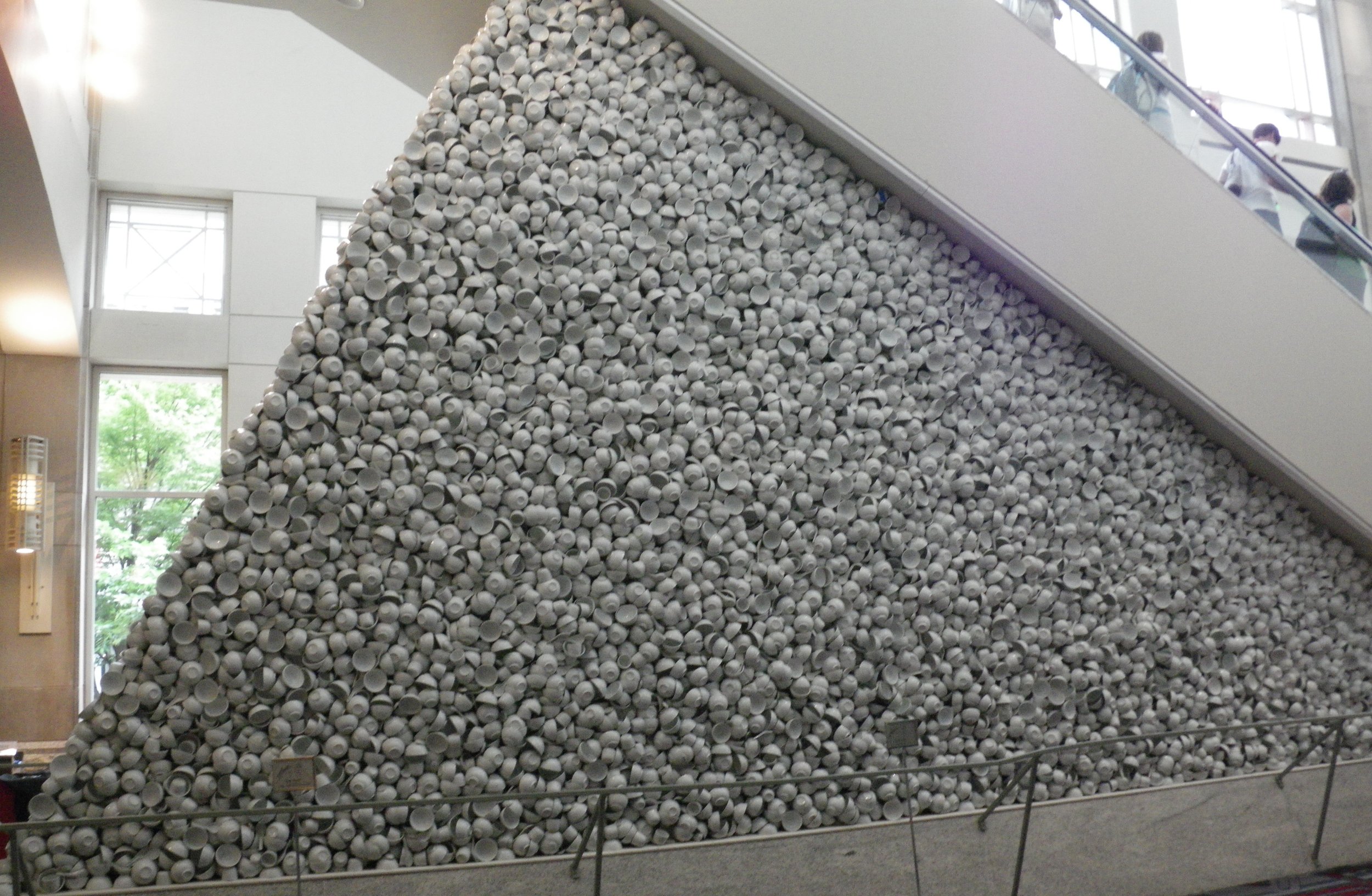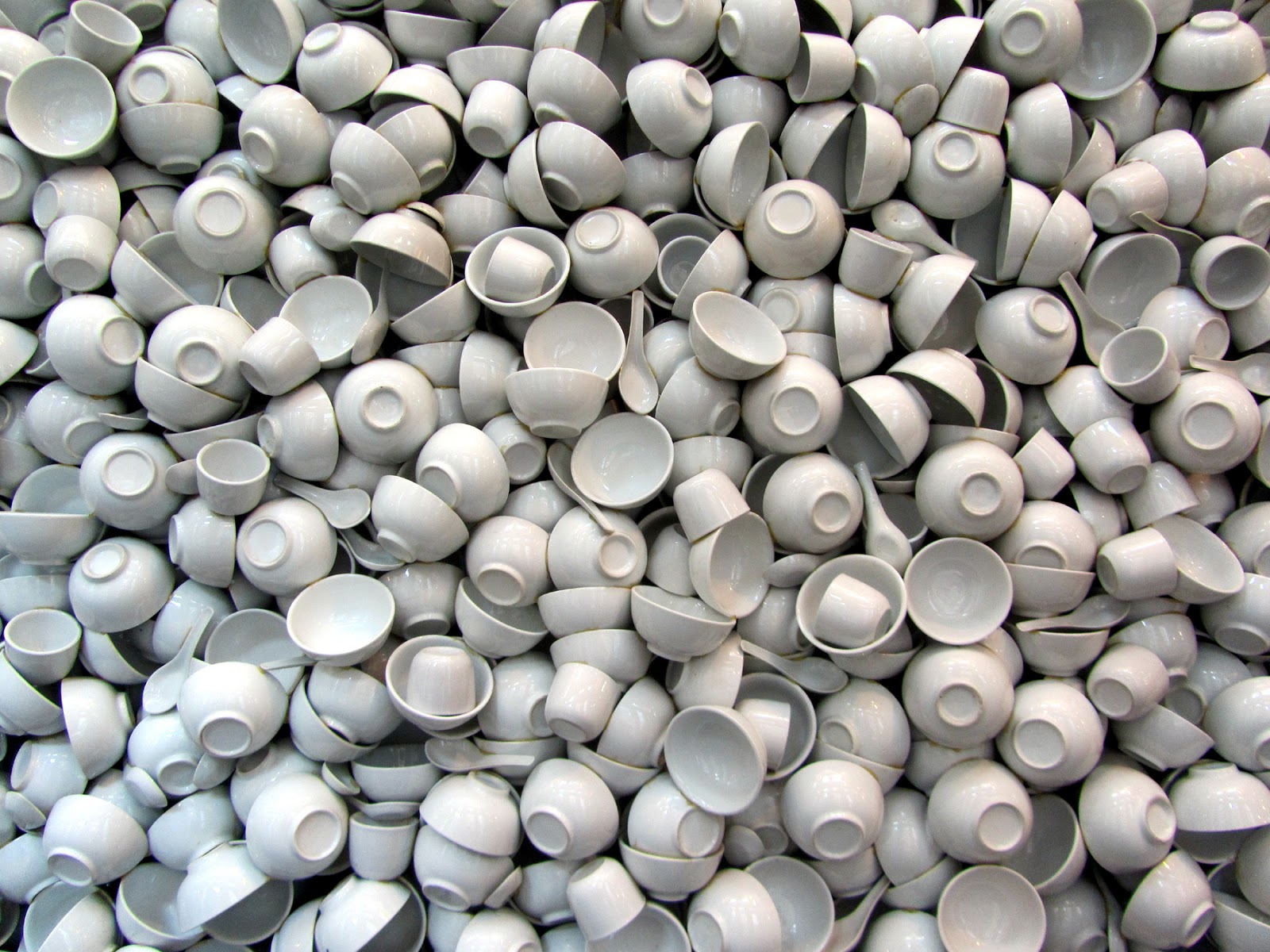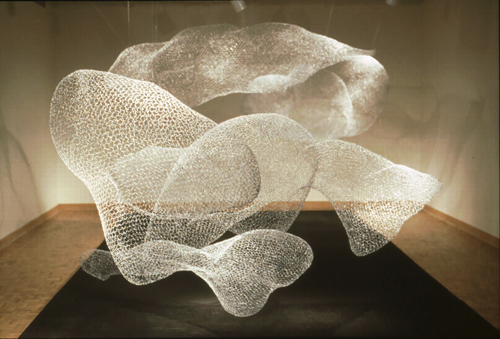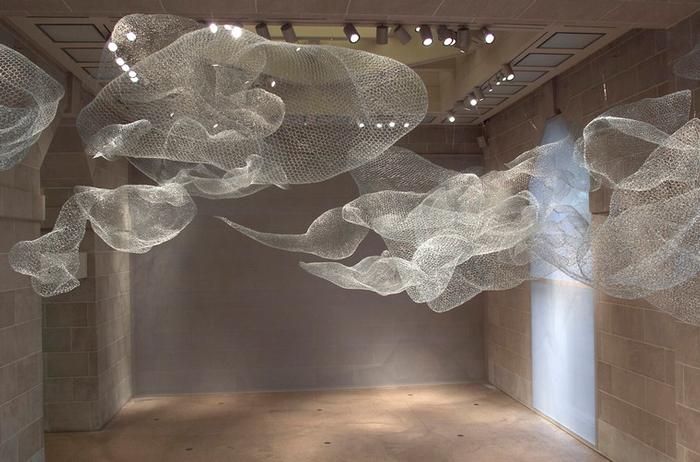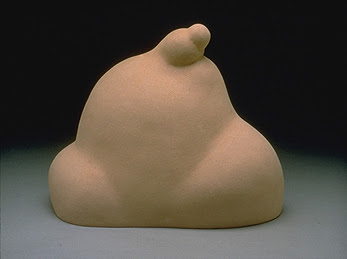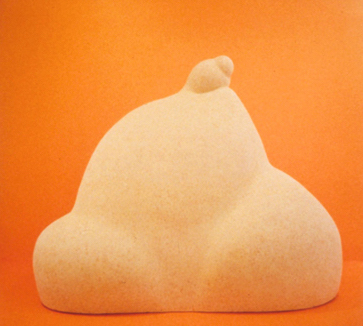Cultural Voyaging - Sculpture Magazine, March 2011
"Mei Ling Hom is an American artist whose work is distinguished by her affinity with cultures often underrepresented in contemporary art. Based in Philadelphia, Hom’s world travels have led to rich social interactions that have enhanced her work. She is an astute observer who pays attention to details often overlooked by others.
Hom is a versatile artist. She has created installations that are assertive and monumental as well as building works that appear weightless and ethereal. While always poetic, her pieces can be political as well. With great sophistication, Hom addresses issues of cultural identity, gender, and globalization.
The majority of Hom’s work is site specific. With titles such as; "Thai Space", "China Wedge", "Floating Mountains, Singing Clouds", and "Golden Mountain", her pieces engage current issues while they also remain attuned to historic forms. These works transcend borders presenting ideas that are both introspective and universal.
Hom’s first major permanent sculpture was a commission built for the Pennsylvania Convention center in downtown Philadelphia. This 1994 work, "China Wedge", was simple in concept yet was a challenge to fabricate. An enormous wedge composed of 22,000 small white tea cups, rice bowls and spoons of the type typically found in Chinese restaurants defines a space between an escalator and the floor below it. At its highest point this installation measures 22 feet from floor to ceiling and it stretches 40 feet in length. Hom and her construction team spent hundreds of hours gluing the porcelain to an intricate hidden structure.
It was a technical and logistical challenge to build "China Wedge". With a tight deadline, containers of dishes needed to be sourced, ordered, and shipped from China. Determining the correct adhesive that would hold the ceramics to the base and to each other took a great deal of trial and error. The steel and concrete board frame was complicated and even understanding how to position the scaffolding for access to the work area was not obvious.
Hom overcame these technical complexities and "China Wedge" is elegant, compelling and provocative. According to Hom, generations of Chinese Americans were considered second-class citizens with few employment options in their adopted homeland. Working in a restaurant, running a laundry, or small grocery store offered basic subsistence. Like other immigrants, the Chinese had to “wedge” their way into the mainstream of America society and demand equality.
The impact of "China Wedge’s" message is heightened by the Convention Center’s proximity to Philadelphia’s traditional Chinatown. Built within one block of the neighborhood where many Chinese immigrants started their life in Philadelphia, the sculpture invites viewers to adopt a critical orientation towards historic processes of immigration and assimilation. Hom, of course, was acutely aware of this productive juxtaposition.
Just a year before Hom created "China Wedge", she spent six months in Thailand as a recipient of a Lila Wallace – Reader’s Digest Arts International Residency. Her time in Thailand culminated in an installation entitled "Thai Space" at the Fine Art University in Bangkok. In contrast to the massive and politically charged "China Wedge", "Thai Space" which is made primarily of fabric and soft materials is both delicate and impressionistic.
"Thai Space" is a work about the artist’s experience in a complex culture not her own. In this installation she presents a visual collage composed of a collection of images and impressions dream-like and implied. Everyday objects are shown but totally out of context. "Thai Space" is a work about observations not conclusions.
Using locally significant colors and materials, Hom transformed a conventional Bangkok gallery. Hom uses saffron colored cloth affixed to the gallery walls to set the tone for the installation. Suspended from the ceiling is a large floating white cube made from mosquito net fabric which Thai householders use to protect themselves as they sleep. Her use of saffron colored cloth is a reference to monks immediately understood by any Thai viewer. Likewise, white is the color associated with devout Buddhist women and when seen in proximity to the saffron cloth this connection is clear. Hom included several other items that are common in Thailand. A motorcycle tire, a fish basket, a canal scoop as well as other objects were wrapped in white saa (mulberry) paper. Devotional candles manipulated to form a U shape were hung under the mosquito net cube. Hom suggests that these elements represented “both the smiles used to cover emotion in Thai culture and the furrowed frowns facing a recently industrialized nation”.
In 2001, Hom constructed "Silkworm Grind" in collaboration with the Fabric Workshop and Museum. This installation is a visual poem, symbolic and commentative in nature. In discussing "Silkworm Grind", Hom explains, “In my travels through Asia I have been struck by the immensely patient and detailed daily work that is the lot of women. Much as the silkworm labors to spin a long thread of string, supple and beautiful silk, which can be woven into fabric, we all go about our daily tasks seeking to create a meaningful whole”.
"Silkworm Grind" is Hom’s first work to include auditory and olfactory elements. In this case humming motors drive the three silkworms in eccentric circles. There is a repetitive grinding quality to the sounds of these motors that helps to reinforce and enhance Hom’s desire to symbolically give form to the daily work of the women she observed. Hom’s three silk worms rotate over mounds of Five-Spice Powder, a blend of spices found in all Chinese grocery stores. The potent smell of tunghing (Chinese cinnamon), cassia buds, anise, ginger root and cloves add an additional dimension to the installation.
While Hom talks about "Silkworm Grind" as a work about the observation of others’ lives, the pungent spices make it personal. Hom’s childhood home in New Haven, CT was an apartment over her parents’ grocery store. As often is the case, one of Hom’s strongest memories of this vast and vibrant shop is the smell. Five-Spice Powder has a distinct and powerful scent. In adding this aroma to her work, the viewer is invited to experience a small part of Hom’s history.
"Floating Mountains, Singing Clouds" was a site-specific installation created in 2006 for the Contemporary Asian Art Program at the Freer and Sackler Galleries in Washington, DC. This program is designed to encourage new ways of thinking about Asian art and culture. Exhibitions are presented in the entrance gallery of the elegant I. M. Pei designed Sackler Gallery. Hom was the first American asked to show in this space.
Hom invited Beijing based musician Eli Marshall to collaborate with her, pushing the boundaries of the dialogue. Marshall is an accomplished artist who studied both at Yale and the Curtis Institute of Music in Philadelphia. He has lived in China for several years and Hom felt his contribution to the discussion on Asia would be relevant.
This small gesture, inviting a non-Asian into a place reserved for Asians speaks volumes regarding Hom’s worldview. As a Chinese American woman she has experienced being pigeonholed. She knows the limitations of such perceptions and in collaborating with Marshall defies expectations. Marshall’s musical contribution to the work enriches Hom vision in an aesthetic way while his very participation in this project adds a political dimension.
In the simplest terms this installation is a landscape both literally and conceptually. Hom, who has a deep understanding of Asian art history, knows well the significance of the landscape in historical Chinese art forms. Although "Floating Mountains, Singing Clouds" is a truly contemporary work of art, it is realized on an historic foundation that is reinterpreted and redefined.
Since gaining her MFA from Alfred University in 1987, Hom has often used hexnet, more commonly known as chicken wire, to realize her ideas. She has manipulated this humble material into many refined and elegant forms. In "Floating Mountains, Singing Clouds", once again, Hom chooses hexnet as her medium. This wire textile has the capacity to define shape yet appear like a three dimensional drawing in space. Although Hom works in marble, clay, bronze, wood and other materials it is often hexnet to which she returns because it at once palpable and evanescent.
Clouds also reoccur in Hom’s art. A common element in Chinese art, clouds often take on symbolic significance. Here we see the artist responding to both her heritage and her experience. Once Hom stated that she “was intrigued by how little Chinese culture I know officially, but how much I know informally”. Her attachment to clouds illustrates this observation. Over the years, Hom has fabricated clouds in vastly different materials, from felt to stone and, in this installation, wire hexnet. "Floating Mountains, Singing Clouds" constitutes her most ambitious exploration of this form to date.
Returning to Thailand in the fall of 2008, Hom reworked her clouds in a more intimate manner. Working at a foundry in the historic city of Ayutthaya, she produced a series of small cast bronze cloud forms. Hom plays with the ability of the bronze colors to enhance and manipulate light on the surface of these sculptures. There is a density to bronze that is the exact opposite one sees in the transparent and weightless hexnet.
While some of these clouds are explorations of form, others become a surface for poetry. Thailand is a country where food is of prime importance. The Thais have a highly defined cuisine that is complex and deeply rooted. Hom engages with this tradition by inscribing royal Thai poems about food on a few of these sculptures. While poems about food on an elegant bronze may seem odd to a Westerner, as with earlier works from her Thai residency the form and content would be immediately comprehensible to a Thai viewer.
Currently Hom is undertaking two large commissions based on her installation, "Floating Mountains, Singing Clouds". Both of these projects are for airports, one in Philadelphia and the other in Raleigh Durham. Undoubtedly, in the contexts of an airport, floating clouds will be perceived quite differently then when seen at a museum dedicated to Asian art. References to China will be lost and these airport clouds will more likely be seen as a poetic prelude to an encounter at 30,000 feet that will soon be experienced.
Mei Ling Hom continues to travel, expanding her range and visual vocabulary. She is an artist who remains committed to stimulating dialogue between cultures and presenting the exceptional as well as the common, regardless of borders."
